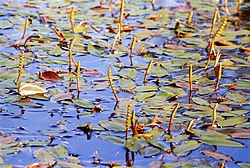Potamogeton natans
Appearance
| Potamogeton natans | |
|---|---|

| |
| Scientific classification | |
| Kingdom: | Plantae |
| Clade: | Tracheophytes |
| Clade: | Angiosperms |
| Clade: | Monocots |
| Order: | Alismatales |
| Family: | Potamogetonaceae |
| Genus: | Potamogeton |
| Species: | P. natans
|
| Binomial name | |
| Potamogeton natans | |
Potamogeton natans, commonly known as broad-leaved pondweed,Holarctic Kingdom.
Description

It produces both floating and submersed leaves on the same plant. The floating leaves are
cordate
at the base. They are dark green, leathery, opaque, with translucent longitudinal veins. They are 5 to 10 cm long, pointed at the tips, and rounded at the base.
The stipules are 4 to 17 cm long.
The submerged grass-like structures are called phyllodes, are actually modified leaf stalks.
The stems are cylindrical, without many branches, and grow from 1 to 2 metres.
The main difference between this species and other pondweeds is a discoloured flexible joint just below the top of the long leaf stalk.
The flower spikes are dense, and cylindrical. They are 5 to 10 cm long, pointed at the tip and rounded at the base. It flowers from May to September.
The fruits are 4 to 5 mm long and
obovate.[4]
References
- . Retrieved 11 November 2021.
- ^ BSBI List 2007 (xls). Botanical Society of Britain and Ireland. Archived from the original (xls) on 2015-06-26. Retrieved 2014-10-17.
- ^ NRCS. "Potamogeton natans". PLANTS Database. United States Department of Agriculture (USDA). Retrieved 13 October 2015.
- ISBN 978-0-7232-5175-0.
External links
Wikimedia Commons has media related to Potamogeton natans.
Wikispecies has information related to Potamogeton natans.

